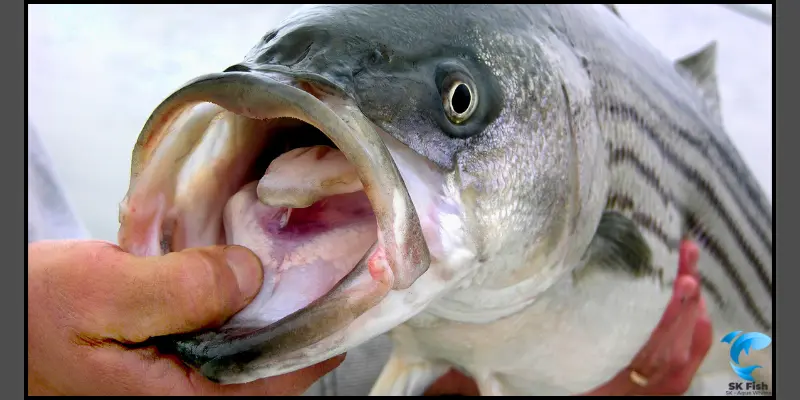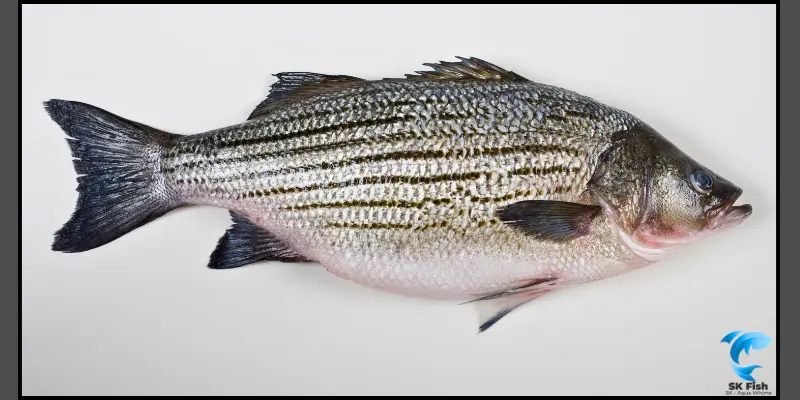The Untold Story of Striper Fish You Need to Know
Published: 8 Jan 2024
Welcome my fellow in aquatic adventures! In this article, we will explore the captivating world of striper Fish. The striper fish (Morone saxatilis) is a large predatory fish with a streamlined silver body.
Are you a seasoned marine enthusiast wanting to know the untold story of striper fish? You’re in the right place. Here we explore everything about striped bass including their habitat, distribution, common names, lifespan, reproduction, and amazing facts.
Let’s begin our exploration!
What is Striper Fish?
The Scientific name of striped bass is “Morone Saxatilis”.Striped bass exhibits a variety of colors including black, white, silver, and shading to olive-green. These species belong to the “Moronidae” family.
Striped bass can have different mouth types ranging from big to small. The striped bass has amazing facts — let’s explore Habitat and Distribute all the nuances of striped bass.

Common Names
Striper fish has different names, it is commonly known as brass, rockfish, stripers, squid hound, green head, pimpfish, and linesider. These species are easily identified because of their 7 to 8 black stripes on each side of striped bass.
World Record Weight and Length
A mature rockfish can grow up to 2 to 3 feet (24 to 36 inches). But they can grow up to a maximum of 6 feet. The biggest striped bass was recorded in 1896 with a weight of 36kg. But the average weight of brass is 10 to 30 pounds (4 to 13kg).
Lifespan and Reproduction
The lifespan of the Bass fish is 10 to 30 years. During their initial two years, most bass reside in the river of their birth. Striper fish pose a mystery as they primarily inhabit saltwater, but when it’s time for mating, they make a remarkable move to freshwater.
In this species, male bass mature quickly at 2 or 3 years, while females take longer, reaching maturity at 5 or 6 years. During spawning, multiple male bass court a single female, after which the female bass lays eggs in freshwater near the shore.
Habitat and Distribution
Let’s start to explore the habitat and distribution of Striper fish.
Habitat
Stripers are more agile in warmer water, with a preferred temperature ranging from 55 to 68 degrees. While they are primarily found in coastal waters, Striped Bass possesses a remarkable ability — the capacity to thrive in both saltwater and freshwater environments.
During the spawning season, they migrate from saltwater to freshwater. Spawning typically takes place in the spring, where a female stripper lays approximately 2 million eggs. After 2 to 3 days, these eggs hatch into yolk-sac larvae.
Distribution
The distribution of rockfish is very vast. Particularly, most of the striper fish are abundant along the Atlantic seaboard. Also, an extensive portion of stripers is covered from the eastern coast of North America — ranging from the St. Lawrence River in Canada to the Gulf of Mexico.
Striper fish are known for their migratory behaviors, along the coast and into estuaries and rivers. The seasonal migrations of stripers contribute to their widespread distribution.
Threats
Stripers are diminishing Constantly due to the increasing fishing activity targeting them. Typically, small stripers fall prey to predators such as bluefish, cod, and silver hake. As for adult stripers, they commonly face predators like seals and sharks.
The other threat of stripers is reduced food supply — and hypoxia (low oxygen). And these challenges are not going away.

Is Striped Bass Good to Eat?
Yes, stripers are good to eat. But it depends on who asked this question. Because stripers are high in mercury — due to this reason pregnant women and children don’t eat striped bass.
Taste of the Striped Bass
Succinctly, stripers are listed as one of the most delicious tasty fish. The taste of striper fillet is mild and sweet — if it is cooked perfectly, it is the popular choice for grilling. In the northeast Atlantic Region, stripers are considered perfect for eating.
Cooking Methods
There are so many methods to cook striped bass. But most of them are popular worldwide — Grilling, baking, pan-searing, or broiling. Grilling and broiling are some of the most popular dishes.
If you want to learn more about different delicious recipes. So, click the link.
Diet and Feeding Habits
The feeding habits of stripers are divided into different stages. During their early stage (Juvenile Stage) stripers feed on zooplankton and insects — which helps to grow and become larger prey.
In the sub-adult stage, they feed on small fishes like baitfish such as herring, shad, and anchovies. In the adult stage of stripers, they target large fish like squid.
Now, let’s talk about the feeding behavior of stripers. Stripers adopt different feeding behaviors such as ambush predators, surface feeding, and nocturnal feeding. They feed actively in the night such as during low-light conditions.
| List of Fishes that Striped Bass Eat |
|---|
|

Interesting Facts About Striped Bass
| Amazing Facts |
|---|
|
Conclusion
So, we’ve delved into all the essential aspects of Striped Bass. From their intriguing facts, including various names and the world record weight and length, to their habitat, distribution, threats from other fishes, diet, feeding habits, and the delectable taste of stripers, we’ve covered it all. By discussing these crucial elements, we hope this information proves valuable to you.
Frequently Asked Questions
Is Striped Bass/Rock Fish a good fish to eat?
Yes, Striped Bass is indeed good to eat, but it’s essential to consider who is asking. Pregnant women and children are advised to avoid consuming Striped Bass due to its higher mercury content.
Is a striped bass freshwater or saltwater?
Striped bass lives in both freshwater and saltwater. During spawning season they moved to freshwater. Striped bass is renowned for its migratory behavior. Because they were born in saltwater and spent most of their time in freshwater.
What is the biggest striped bass ever recorded?
A fortunate fisherman once caught the largest Striped Bass on record, weighing an impressive 81 pounds (36 kg).
Do sharks eat striped bass?
Yes, big predatory fishes like sharks, barracudas, and groupers eat small fishes including striped bass.
How big can striped bass get?
A mature rockfish can grow up to 2 to 3 feet (24 to 36 inches). But they can grow up to a maximum of 6 feet.

SK Fish is your trusted source for practical fish care tips and delicious seafood recipes. Our team is dedicated to providing reliable, well-researched content for fishing enthusiasts and home cooks alike.

- Be Respectful
- Stay Relevant
- Stay Positive
- True Feedback
- Encourage Discussion
- Avoid Spamming
- No Fake News
- Don't Copy-Paste
- No Personal Attacks



- Be Respectful
- Stay Relevant
- Stay Positive
- True Feedback
- Encourage Discussion
- Avoid Spamming
- No Fake News
- Don't Copy-Paste
- No Personal Attacks





